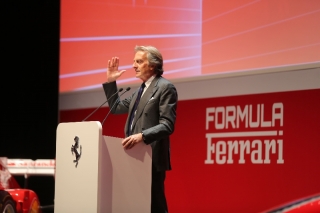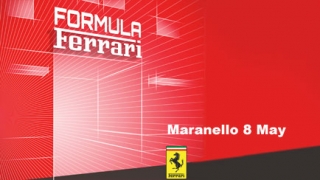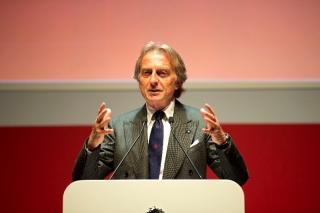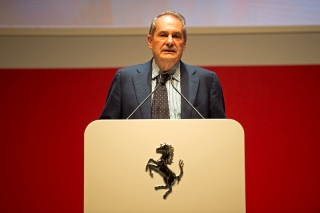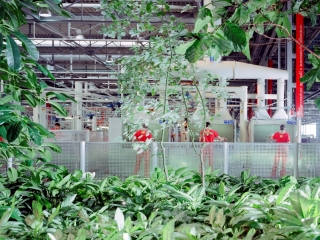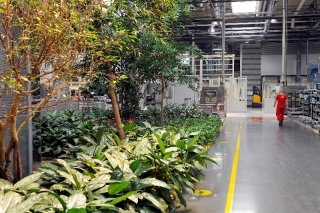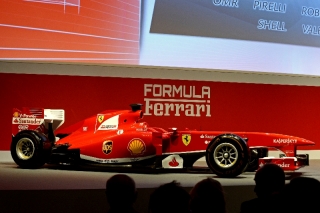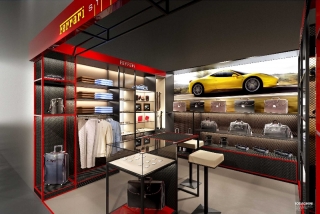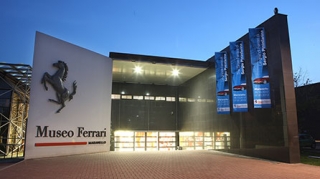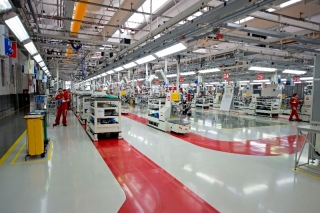A Formula Ferrari day in Maranello
Posted: 08.05.2013
Source: Ferrari
Maranello 8th May – Today more than 250 journalist from 34 different countries visited the Maranello factory for the Formula Ferrari Press event. Media representatives from as far afield as Japan, Indonesia and the Middle East joined more local journalists from Europe, representing a range of magazines, newspapers and TV stations.
The group, on Tuesday, first visited the new Ferrari Store which has just re-opened opposite the factory. The store has been transformed and the guests were able to enjoy the floor space increased to 650 square meters and a new concept designed to give customers an experience of the Ferrari world. Later the group visited the Ferrari Museum to see the new exhibition of “Ferrari’s from another world” exhibition showcasing never before seen “Mulotypes” – machines used to test new technology and develop new models. They also experienced the exhibition about the new La Ferrari. Today the groups enjoyed an extensive tour of the factory including the Taylor Made department, V12 vehicle production line, the Classiche department and the new €40 million engine plant.
The group also enjoyed presentations about the sustainability of the company, its products and processes and the importance placed on developing the workforce of 2,900 people who work at Maranello.
They then attended a Press Conference where they sat on designer chairs made from recycled cardboard – to further emphasize the importance Ferrari places on sustainability.
Ferrari CEO, Amendo Felisa, addressed the journalists to explain the innovations and developments in Ferrari recently. He focused on the effort and investment that has gone into research and development in order to reduce C02 emissions while still be able to increase power and drivability. Luca di Montezemolo welcomed the guests reiterating the importance of the companies key asset – the work force. He also announced the creation of 250 new jobs in Italy this year. He explained the current turn over by region and the way the market was being targeted towards 2017. He concluded by announcing the first quarter results for 2013 with 1,798 road car sales, a 42% increase in trading profits and a 36.5% increase in net profits.
Formula Ferrari
Posted: 08.05.2013
Source: Ferrari
Maranello, 8 May 2013. Passion. Diligence. Innovation. Determination. Research. Motivation. Excellence. Investment. Technology. Talent. Training. Exclusivity. Selection. Style. Merit. Team spirit. There are many elements that go to make up Ferrari’s DNA. The secret is in its people – because behind our exceptional cars there are equally exceptional men and women – and in the knowledge that goes into combining all these ingredients, in every sector of the company’s activities: from design to production, from road cars to race cars, from the sales network to the development of the brand, from training to services provided for the employees, from customer care from the order to final delivery, this is Formula Ferrari.
Formula Ferrari – Luca di Montezemolo: “Ferrari must remain exclusive”
Posted: 08.05.2013
Source: Ferrari
Maranello, 8th May – Luca di Montezemolo addressed more than 250 members of the media today at the Maranello factory to explain key areas of the business to the media, as well as announcing impressive results for the first quarter of 2013.
“I base my plans for Ferrari on four key areas,” said Montezemolo. “Our team spirit, our passion, our extreme technology and our exclusivity” this is how he summed up his feelings to the assembled journalists from over 30 countries.
Montezemolo announced impressive first quarter results for Ferrari. A total of 1,798 road cars were sold, excluding the pre-sales of La Ferrari, an increase of 4% on the first quarter of 2012. Revenues also increased to €551 million, an increase of 8%. Trading profit was also up 42% standing at €80.5 million with Net profit up 36.5% to €54.7 million.
He also explained his vision not to increase the production numbers of Ferrari road cars in 2013, the production will be less than 7,000 in 2013.
“I want Ferrari to remain exclusive,” he explained. “A Ferrari is like a beautiful woman, she must be worth waiting for and desired. I base my ideas on what I learned from Enzo Ferrari, if we produce less cars, we will not flood the market and it makes our used cars more desirable too.”
The chairman also discussed Ferrari’s investment in the future with an international work force already standing at 2,900 people, he announced that 250 new jobs will be created in Italy this year, with a 20% increase in blue collar workers and opportunities within 3 years for 100 workers to be promoted to professional white collar roles.
“It is my dream that I am replaced by someone who has come from a blue-collar role,” Montezemolo enthused. It was not just the investment in the workforce that he announced, but also a €100million investment from now until 2015 in the environment in which everyone works. This is on top of the €4 million already invested each year in the workers and their families.
Montezemolo pointed out that innovation is the key to success of Ferrari – none of the models follow the same design – each are individual form the 12 cylinder cars such as the FF to the 8 cylinder California which continues to be the top performing model in the USA. He summed up the range as “Different Ferraris for different Ferraristi.”
He went on to explain that Ferrari is the strongest brand in the world with 95 items displaying the prancing horse sold worldwide every minute. With an international presence in over 61 countries there are currently 54 dealers in the USA, 27 in Great China (a number that is set to increase), 101 in the Europe, Middle East and Asia (EMEA) region and 17 in the Far East (also set to increase).
By far the biggest turnover per market belongs to the EMEA region with the far east and Greater China following second with 28%. Ferrari aims to develop the American market to such a point that it can reach 30% of the turnover by 2017.
Formula Ferrari – Amendo Felisa: “More investment in research and development”
Posted: 08.05.2013
Source: Ferrari
Maranello 8th May – Ferrari’s CEO Amendo Felisa spoke to the Formula Ferrari press conference today to explain the work the company has been doing to increase the performance of its road cars while still reducing emissions and consumption. He explained that at least 17% of the annual turnover was invested in product development and through this investment that they had managed to reduced C02 emissions by 40% but with an increase of 100 horsepower in the last 5 years. He also pledged €250 million for research and development into the reductions of emissions in the following 5 years. Felisa stressed the importance of weight reduction in emissions and performance showing that Ferrari had not only moved to the use of aluminum in production, but 12 different aluminum alloys. He also touched on the importance of the work of the Formula 1 team as the most important development of technology to transfer to new cars. The plans are to make the production facilities at Ferrari the perfect balance of craftsmanship and advanced production technology. The perfect example of this is the new €40 engine production plant at the factory. Sustainability also plays a key role in Felisa’s view for the future of Ferrari – although energy consumption has increased by 10% between 2008 and 2012 the resulting C02 emissions for the same period were reduced by an impressive 40%. All new buildings for Ferrari are built to eco-friendly standard and the new Scuderia Ferrari center will be a Zero Emission facility, which is far ahead of the 2020 European targets.
Formula Ferrari – People
Posted: 08.05.2013
Source: Ferrari
Ferrari’s greatest asset is its workforce of 2,900 people who work in Maranello and Modena Scaglietti (95%) and externally (5%,) divided 60/40 between blue and white collar workers.
10.5% are women and the overall average age is 38, with a high level of education: 60% of the blue collar workers have a diploma, while 70% of white collar personnel have a degree. The percentage of non-Italians is 5% among the shop floor and 20% of the office workers and they come from 29 countries.
The people
Ferrari is a company that rewards excellence: those who are deserving, who show ability and determination can and must grow. The culture of merit is part of the DNA at Ferrari, because only excellent people can win the challenges faced in the market place and on the race tracks around the world.
This also means knowing how to appreciate people and marry expectations with specific organizational demands. With this in mind there are clearly defined made-to-measure routes to growth based on the characteristics of the individual, while considering the aims of the company, supported by significant investment in training.
Over the past three years, the workforce as a whole has had over 120,000 hours of training, as part of a five-year personal training plan known as “Progetto Tailor Made,” in which the company invests 3 million Euros per year.
One of the tools for ensuring and increasing technical and professional knowhow is the School of Expertise. Established in 2009, the School is open to all office and factory workers who can avail themselves of tutors and internal teachers, so that in turn they can become the engineers and specialists of the future.
Participation and involvement are at the core of relations with the personnel and that also means sharing the successes, according to a simple rationale: the more the company wins, the more the employees win. That is how, in 2012 alone, the value of the competitiveness prize given out was equivalent to 20% of the average salary. That is how, thanks to the extraordinary results of the three year period 2010 – 2012, each Ferrari employee received an additional three months pay and the challenge is on again for the next triennium.
Growing together
At a time when the whole world, but Europe and Italy in particular are experiencing an incredibly hard and long economic crisis, Ferrari has continued to invest in its products, in innovation and in its people, guaranteeing jobs and future growth.
Currently in progress is an employment programme, which is destined to see 250 youngsters join the company, chosen with criteria aimed at the search for excellence, while matching with Ferrari values. Particular attention is paid to internationalism and a multicultural approach, as well as ensuring that it is a match for the best organisations in the world. It is with this aim that, within the Human Resources Department, the “Talent Acquisition & Development” entity has been established to increase the ability to spot the most talented individuals from all over the world. One of the cardinal points is collaboration with Universities, not just in Italy, but also those from abroad. One example is the relationship with Oxford University where a Ferrari office has been set up within the Begbroke Science Park, where a research group is working on software development and simulation.
Growing together also means stimulating the creativity of the individual. For this reason, programmes have been implemented with the aim of stimulating the development of ideas and solutions to improve the product, the working methods and the working environment.
Pole Position Evo rewards the ideas of the individual: in 2012 over 3000 proposals were put forward with 56% of the blue collar workforce taking part. Pit Stop encourages team spirit and last year, the group efforts of 108 people were recognized.
Formula Ferrari – Sustainability
Posted: 08.05.2013
Source: Ferrari
Ferrari’s efforts relating to sustainability come to fruition in the polluting emissions reduction programme, through the improvement of efficiency in the cars themselves and in the production process and through the Formula Uomo project launched in the early Nineties by President Luca di Montezemolo. This involves seeing the personnel as the cornerstone of the company’s activities. The concept of environmental sustainability, a responsibility towards the community that is home to the Maranello campus and to its own workforce, is therefore inextricably linked to the quality and safety of the working environment, a unique formula without parallel in the world.
All-round energy efficiency
Ferrari has invested heavily in the strategic area of the environment since 2001, when the company was given the ISO 14001 certification, which was then reconfirmed in 2010. In 2007, it received the Integrated Environmental Authorisation, while 2008 saw the start of self-produced energy with the first solar panels fitted over the Machining building. From 2009, the biggest energy producing plant in Italy went into operation, producing electricity and hot and cold water, using natural gas. Added to this in 2011 was a second solar panel installation over the Wind Tunnel offices. With the linking up of all its buildings Ferrari is now completely independent in terms of energy production, achieving a reduction in CO2 emissions of 42.1% and 66% of Particulate Matter (PM.) Ferrari has thus reached the Kyoto objectives well ahead of schedule and with double the figures required in Europe. The energy project forms part of the Formula Uomo project, with the aim of putting the workforce, their needs and abilities at the heart of the company’s activities.
As for the actual cars, in 2007, Ferrari set itself the target of achieving a 40% reduction in consumption and emissions for the range by the end of 2012, through the application of a road map that aimed for an improvement in energy efficiency (increasing the energy produced) and the vehicle as a whole (reducing its energy requirements.) Hitting these targets in conditions of real use of the cars by their owners definitely did not stop the research in these areas carried out by the Maranello engineers, with the result that the first months of 2013 saw the introduction of the first Ferrari that makes use of hybrid technology.
A new gas furnace has been fitted for the production of the main engine components (cylinder heads, cam covers, cranckases, sumps) through the fusion of aluminium. Apart from ensuring even higher quality of manufacture, the furnace consumes 70% less energy, while at the same time increasing the smelting capacity to 1500 kg per hour.
Furthermore thanks to the automation of the loading-unloading procedure, the new installation has significantly increased the safety levels for the workers, who are no longer exposed to the line of fire.
Working environment: wellbeing and safety
The quality of the cars cannot be disassociated from the quality of life of those who work at Ferrari. Good lighting, air conditioning, a low environmental impact, safety, noise control, green and restful areas, along with the most advanced technologies, are the stand out features of an organisation based on the principles of Formula Uomo. The project was established to allow all employees to best express their talent, creativity and passion.
Over the past few years, further significant investment has been made to increase the green areas. These can be found both inside and out of the various factory buildings and today cover a surface area of 165,000 square metres. Aloe arborescens, buddleja blue and dianthus carthusianorum are just some of the hundreds of plant species than one can admire when strolling through the grounds of Maranello. Sitting on a bench surrounded by greenery during a break, looking out the window drawn by the sound of an engine and even on the production line, it’s inevitable that ones eyes are drawn to a bush in flower, some ferns or an evergreen tree. The engine assembly line boasts orange poppies, while the mechanical department has tropical lilies, gems of rare beauty that flower within the buildings. And that’s not all, with 25,000 flowerbeds, gardens and all sorts of trees, the Ferrari campus is an innovative workplace where people’s wellbeing and the quality of the working environment always come first.
There has also been a huge investment in safety at work, through the actual structures and specific training, which has achieved significant results in all sections of the company. Particularly effective has been the programme to highlight so called near misses, which is to say, events that could have caused accidents, thanks to an effective involvement of the employees. Still on the topic of safety, there are defibrillators in every building.
Net Zero Emission Building: the future is already here
After the Wind Tunnel, the Machining Department, the New Logistics, the Product Development Centre, the New Paint Shop and the Company Restaurant, as well as the new Car and Engine Assembly buildings, the next building that must respond to the criteria of Formula Uomo is the new home to Scuderia Ferrari. For this project, the work of French architect Jean-Michel Willmotte, Ferrari wanted to raise the bar even higher. This is to meet the new European standard which will not be the norm until 2021, when all newly built private buildings will have to be nZEB (net Zero Emission Building,) which means that, over the course of a calendar year, they will have to present an algebraic figure relating to energy flow both on entry and exit of zero.
In planning the new home for the Scuderia, Ferrari was strongly inspired by wanting to adopt the nZEB philosophy ahead of time, with an operation which, partly because of its size, is a particularly challenging task today.
Achieving such a high energy target involves firstly going through a carefully planned mix of technological strategies aimed at reducing and optimising the energy requirements by making the maximum use of natural light, improving thermal isolation of all the walls, high efficiency air conditioning, combining sophisticated control systems for ventilation and temperature in every environment, so as to achieve the highest levels of quality and comfort in the internal areas.
The second characteristic which goes to qualify the construction as nZEB is the major use of renewable energy production technologies, such as photovoltaic and solar power.
With its new headquarters for the Scuderia, Ferrari thus enters the field of energy experimentation at the highest level, which today sees the involvement of excellent research and development facilities from around the world, such as NASA with its Facility Building at Cape Canaveral, the DOE (Department of Energy of the United States) and the German EnOB (Forschung fur Energieoptimiertes Bauen.) It’s a field in which Ferrari wishes to get involved, creating a building that is not restricted simply to an exercise in pure energy engineering, even if it is applied to such a large building, but which at the same time is architecturally harmonious and functional, perfectly in line with the principles that govern the continuous development of Campus Ferrari, respecting the local area and the people who, every day, contribute to renewing the legend of the Prancing Horse.
Formula Ferrari – Formula 1
Posted: 08.05.2013
Source: Ferrari
Formula 1 always has been and continues to be not only the expression of an essential part of the Ferrari DNA, but also a true academy for technological research. One always has to keep in mind the possibility that ideas and solutions can transfer from the racing car – designed within the ever more stringent restrictions of the regulations and made to measure to fit the drivers – to the production of the most beautiful road cars in the world. Formula Ferrari is a platform to examine three topics: the introduction of hybrid technology, the evolution of fuel consumption over the past decade and the impact of simulation on aerodynamic development.
Simulation
Over the past 20 years, aerodynamics has become the area of the car that has the greatest influence over its performance, taking it progressively further away from its road car relatives. But above all, it has led to an inexorable and unacceptable escalation of costs. Indeed, the imperative to reduce these costs has led to the gradual introduction of several restrictions, from the size of the models used in the wind tunnel to the number of hours these facilities can operate. However, at the same time, technological progress, especially in the area of IT, has led to a new way of studying aerodynamics – Computational Fluid Dynamics – which has led to a huge increase in the possible ways of improving ones knowledge of a car’s aerodynamic behaviour and as a consequence, of making it more efficient: in fact making a car faster and giving it a better chance of winning. To understand the impact of this technology, one only has to look at Table 1, which shows the increase in calculation power in this sector over the past fifteen years.
Table 1
| Year | CPU | RAM | Run in GdV** |
| 1997 | 3 | 1 Gb | 0,3 |
| 2002 | > 100 | > 30 Gb | > 1 |
| 2007 | > 1000 | > 180 Gb | > 100 |
| 2012 | > 5000 | > 1 Tb | > 700 |
** Run in GdV: number of single tests carried out in a wind tunnel in one week
The table shows how the available firepower has increased and how logical it is therefore that aerodynamics has become the key element, also in light of the limitations imposed in the regulations on other areas, starting with the freezing of engine development.
To provide an instant understanding of how quickly aerodynamic development has grown, we have taken a close look at one element of the car, the front wing-nose assembly, over the course of a four year period in which the regulations remained practically unchanged (2009-1012.) The aerodynamic downforce at a constant speed (300 km/h) exerted on this element has increased by around 40%, as can be seen in Table 2.
Table 2
| Year | Car | Downforce |
| 2009 | F60 | 6.000 N |
| 2010 | F10 | 7.500 N |
| 2011 | F2011 | 8.000 N |
| 2012 | F2012 | 8.500 N |
Evolution of fuel consumption 2003-2013: efficiency and regulations
The decade which marked the switch from V10 to V8 engines was very busy for the engineers designing Formula 1 engines. Changes to the technical and sporting regulations went down three main routes: standardisation of a few key parameters, limitations on, followed by the freezing of development of the engine’s structural elements, prolonging the life of each unit from around 350 kilometres in 2002 to the current 2,500. All this also had an impact on specific fuel consumption, with a reduction of around 10%. More efficient consumption also signified improved performance, especially from 2010, when refuelling during a race was banned. Furthermore, in this area, the support from Scuderia Ferrari’s long time supplier Shell was vital and the company also made a significant contribution to the increase in power from the engine, once all development aimed at performance had been banned. In the graph below, one can see the evolution of specific consumption, influenced in recent years by other factors, such as the introduction of KERS and the use of exhaust gasses to increase aerodynamic downforce and a prediction of how things will change as from 2014, with the arrival of a new powertrain. In fact, next year will see a very significant drop in specific fuel consumption because the engine project will be based on efficiency: the introduction of a fixed maximum flow rate for the fuel, the e-turbo, direct injection and increased power generated by KERS will all be decisive factors in gaining overall efficiency for the powertrain.
From KERS to ERS
In 2009, hybrid technology made its Formula 1 debut with the introduction of KERS, the kinetic energy recovery system produced by the braking forces on the rear axle, which at first was optional. Ferrari immediately took on the challenge and the experience gained in five years of development, (with one year less of track use in 2010,) has proved to be very valuable, both in terms of technology transfer to the road cars and in light of the new 2014 powertrain regulations. Based on the technical regulations, the maximum available power per lap is 60kW for an energy total of 400 kJ. The architecture of the system features an electric motor attached to a thermic motor, equipped with an electronic control unit and a battery pack. Weight, the ability to repeat performance, compact dimensions, installation within the car, as well as the obvious requirements for reliability and driver and crew safety, are the key parameters for assessing the worth of the project, given that its performance gains are fixed by the regulations. Over the course of this five year period, significant results have been achieved in terms of overall efficiency, which can be summed up as follows: -10% volume -20% weight -40% cost per unit -90% cost per race 100% availability for us in qualifying and races
The introduction of KERS has brought other collateral effects, such as steps forward in miniaturisation of electrical and electronic components, the development of advanced systems for storing energy, the training of personnel on the technical side and on management in terms of safety, generally increasing the company’s know-how. 2014 will signal a revolution in Formula 1 with the introduction of a new power supply – a 1600cc V6 with a rev limit of 15000 rpm, fitted with direct injection, an e-turbo and KERS. The “hybrid” element will therefore come from a combination of thermic energy from the turbine and kinetic energy, derived from the now “classic” KERS. Furthermore, the regulations require a maximum fuel flow level of 100 kg/h and a maximum amount of fuel per race of 100 kg, as well as a further extension of engine life with each driver allowed only 5 engines per year instead of the current eight, with a further drop to four in the future. The “hybrid” system will consist of a motor to recover kinetic energy (MGUK) and one for the thermic energy (MGUH) both linked to a battery pack on one side and a motor on the other. The maximum useable power over one lap that can be generated by MGUK will be limited to 120 kW for a total energy value of 4MJ – double the current figure in terms of power, a tenfold increase in overall energy, while what can be stored will be half of it. However, the amount of useable energy produced by the MGUH will be free. That means that, if up until now KERS is an element that can make the difference based on its efficiency, in the future the system will not only need to be efficient, but it will also be able to make the difference in terms of outright performance. In terms of lap times, the gains generated by the new technology are reckoned to be around three seconds, while predicted maximum power will be similar to current levels (around 750 horsepower.)
Formula Ferrari – Brand
Posted: 08.05.2013
Source: Ferrari
The Ferrari brand is the strongest in the world. So says Brand Finance, a British company that is a leader in the business of brand evaluation. Through activities linked to brand (retail, licensing and e-commerce, the aim of the company is to reinforce its brand equity, developing projects and activities that match Ferrari values and complement its core business.
Brand development activities run through licensing and retail programmes – characterised by a clear distinction between the products and the sales channels aimed on the one hand at the world of race fans and on the other to those enthusiasts of the GT cars, not forgetting the world of kids and luxury goods and the creation of a product line sold directly through the Ferrari Stores and at store.ferrari.com.
Partners are only chosen from among the best in each category and they must adhere to targeted benchmarks.
For all its true fans, Ferrari offers various ways to stay in touch and participate in the Ferrari experience, which can be done virtually through ferrari.com and the company’s presence on all the main forms of social networking. There is also a physical entity in the shape of Ferrari World Abu Dhabi, the first theme park dedicated to the Prancing Horse.
Ferrari Pr1ma
Presented for the first time as part of Formula Ferrari is Pr1ma, the collection that, as from today, captures the spirit of the Prancing Horse par excellence.
Pr1ma sets out to be a tribute to the personalities, the icons and the values that, since 1947, have created and continue to nourish the Legend, its mark of excellence and style.
Each item features the finest raw materials and great attention to detail in its 100% Made in Italy workmanship, produced with the same mix of artisanal attributes and technology that is a feature of the construction of the most beautiful cars in the world built in Maranello.
Ferrari Store
A new Ferrari Store has also officially opened at Maranello, with an increase in its surface area from 190 square metres, from when it first opened its doors in 2002 to 650 today. In addition it also represents a new concept created to give customers an experience of the Ferrari world and, through making a purchase, to be part of it. Massimo Iosa Ghini has used quality materials and displayed a complete and original range of objects that express the soul and DNA of Ferrari.
There are now over fifty Stores around the world – in prestigious locations such as Rome, Milan, Venice, London, Barcelona, Madrid, New York, San Francisco, Miami, Macau, Johannesburg as well as Dubai and in Ferrari World Abu Dhabi, with a further presence in Travel and Duty Free locations.
Over 400,000,000 official Ferrari products have been sold in the last ten years: today, every minute, 95 Prancing Horse branded items are sold.
E-commerce
Sales of Ferrari merchandising also take place through store.ferrari.com, Maranello’s official on-line shop. Apart from traditional merchandising, store.ferrari.com also offers the opportunity to acquire limited edition items, as well as GT and Formula 1 memorabilia.
Now available in seven languages, including Russian and Japanese, it gets hits from customers in 165 countries from all around the globe, from near the North Pole in Norway to Tierra del Fuego in Argentina. On average, the site gets 20,000 visits a day and the number of items sold has gone from 55,000 in 2010 to 78,000 in 2012. 14% of transactions are made using iPhone and iPad.
Ferrari World
Ferrari World Abu Dhabi is the first theme park dedicated to the Maranello marque and offers visitors an amazing experience for all the senses. Aimed at people of all ages, it presents a tribute to the Legend and its unique characteristics of passion, excellence, style and performance.
Situated on the Yas island, FWAD has a surface area of 200,000 square metres, all under cover, which makes it the biggest indoor park in the world. There are over 20 attractions for visitors to enjoy, from the must futuristic such as Formula Rossa, the worlds fastest rollercoaster, which can accelerate its cars from 0 to 240 km/h in the same time as a Formula 1 car, to the four dimensional Speed of Magic, or the chance to enjoy a virtual trip through Italy, as well as offering a taste of Maranello cuisine, even though it is thousand of kilometres away. Located in a part of the world that is developing rapidly, at the crossroads of Europe, Asia and Africa, Ferrari World Abu Dhabi has joined the ranks of the top tourist destinations in the world.
Web & social media
Ferrari.com is the official portal to the Maranello marque, the place on the Web through which owners, enthusiasts, fans and the simply curious can learn all there is to know about Ferrari, its products, its past and its present. It is laid out in different sections, which cover all areas of activity, as well as offering exclusive services. Ferrari.com is available in several languages, depending on the sections. For example, GT and Sports Cars, dedicated to the road cars of yesteryear and today, is translated into seven languages, including Chinese and Japanese; the second section, relating to Formula 1 is available in Italian, English and Spanish.
The three year period 2010 – 2012 has seen a marked rise in the number of page visits at ferrari.com, going from 25 million to over 32 million. At the same time, there has been strong growth in terms of views of video content shown on the Ferrari YouTube channel, from just over 4 million to almost 19. Ferrari also has a significant presence in the world of social media, from Facebook to Twitter, from Google+ to Pinterest. Today, the Prancing Horse has over eleven million fans on Facebook, and has just reached the half million mark when it comes to followers of @insideferrari, the Scuderia’s official Twitter account, which puts out the latest news about the most successful team in the history of Formula 1 in real time.
As well as ferrari.com there are the Ferrari dealership sites, available in 61 markets where the marque is officially present, bringing to over 20 the languages in which one can get close to the world of Maranello: a real Ferrari web on the Web.
Formula Ferrari – Places
Posted: 08.05.2013
Source: Ferrari
Museum
Opened in 1990, the Museo Ferrari in Maranello exceeded the outright record of 250,000 visitors in 2012. It offers the ideal journey through the history of the company, displaying the most significant cars from the past, all the way through to the road going cars of today and technological content relating to Formula One. Apart from the section used for the permanent displays, there are areas periodically used for new and important exhibitions dedicated to current events and great moments from Ferrari’s history. From May 2013, the Museum is being extended with a new wing measuring over a thousand square metres, providing further display space and a hall given over to educational activities for school children, a semi-professional F1 simulator and specific area for events, conventions and private and exclusive lunches and dinners.
Car assembly
The New Assembly Line building, designed by Jean Nouvel, brings together technological excellence with the highest level of artisanal skill. It is split into two levels for the assembly of the 8 and 12 cylinder cars respectively. This building is the location for significant technological innovation which allows for the best ergonomics when at the work station, eliminating the more tedious tasks which require no specific skills from the workforce. However, those tasks that do require specific professional skills and manual dexterity to ensure the artisanal nature of Ferrari cars and are a key characteristic of our product, have been retained.
Atelier
Since 1997, Ferrari has offered its customers the chance to personalise their cars to make each one unique, a very successful service, so much so that today, 100% of the cars produced feature at least one element of personalisation. Since it opened in 2008, Maranello’s Atelier has contributed to producing cars that are unique because of the exclusive way they are fitted out. When customers come to the factory they can seek the advice of a Ferrari consultant in helping them define the specification, the choice of details and look at ways of enhancing the appearance and equipment.
Tailor-Made
Ferrari Tailor-Made is an exclusive programme offered by the Maranello company, for customers who wish to define the look of their car, thus strongly expressing their own personality and tastes. The Tailor-Made programme follows a tradition in Maranello that dates back to the 50s and 60s, an era when cars could be personalized with great freedom of choice in terms of materials, leather, marquetry, colours and finish. It was a prestigious past that has been reprised today with the possibility to define every aspect of one’s Ferrari right down to the smallest detail, from the bodwork colour to the upholstery in the cabin, as well as the choice of finish and accessories with a range of different materials, treatments and tones never seen before.
Ferrari Classic
The Ferrari Classiche department, which was set up in July 2006, provides a restoration and repair service. Furthermore, thanks to a technical-historic archive, in which can be found all the data, a dedicated panel of experts is capable of evaluating the technical characteristics of all historic cars and their origins, thus being able to authenticate the cars by producing a legal certificate verifying its heritage and ownership. Thanks to Ferrari Classiche, collectors today can entrust their cars to the people best qualified and who can work with the best tools to ensure a state of the art restoration and provide technical assistance for historic Ferraris.
Engine assembly
There are three engine assembly areas: one for the 6 cylinder Maserati, another for the 8 cylinder engines and another for the V12 Ferraris. On the 8 cylinder line, both Ferrari and Maserati 8 cylinder engines are assembled. The engines to be assembled travel on a shuttle followed by a trolley with the components that are fitted one at a time. In the new 6 cylinder Maserati area, a sophisticated robot assembles the cylinder heads automatically. At the end of the line, it’s time for the first checks of the complete engines, before they are run on the test bed.
Formula Ferrari – Production and processes
Posted: 08.05.2013
Source: Ferrari
For over 65 years, Ferrari has built sports cars that are the benchmark in the sector, partly thanks to the close links to its racing programme, which has always been seen by the company as being a true technological laboratory. Perfection in design, excellence of construction, linked to the highest quality standards in craftsmanship, maximum exclusivity (with just over 7000 cars per year); these are the elements that characterise Ferrari cars, which are built entirely on the Maranello campus. Today, there is the new challenge of reducing consumption and emissions, without forgetting to increase performance and the pleasure of driving. Work continues on technical innovation, a sector in which Ferrari has become the benchmark for the entire motor industry. In recent years, investment has been concentrated on research into materials, with the establishment of the Carrozzeria Scaglietti technical centre for the manufacture of light-alloy chassis, as well as having recourse to F1 technology when it comes to carbon-fibre technology and electronic control systems, which on the LaFerrari have reached a level of complexity and integration never seen before on a road car.
A new and complete range
There are five models in today’s range, all of them delivering their own interpretation of Ferrari’s unique DNA made up of performance, excitement and technological innovation.
The three 8-cylinder models (California 30, 458 Italia, 458 Spider) and the two V12s (F12berlinetta and FF) are a new generation of cars which fully meet the philosophy of “different Ferraris for different Ferraristi,” with each model meeting a different set of criteria. The theme of the sporty 12-cylinder Gran Turismo is interpreted by the FF, the first four-seater, four-wheel-drive car produced by the Prancing Horse. Very high performance with the ability to deliver driving pleasure at lower speeds too is guaranteed with the multi-award winning F12berlinetta.
Of the 8-cylinder machines, the California 30 is the convertible Gran Turismo which combines a sporty feel with usability, without making compromises. The pure sports car, the 458 Italia, and its open top sibling, the 458 Spider, are fitted with the same mid-rear mounted V8, which for two straight years – 2011 and 2012 – has won two categories in the International Engine of the Year award and which continues the glorious tradition of Ferrari cars with this engine configuration.
Added to these cars is the special limited-edition LaFerrari, of which only 499 will be built and which represents the highest expression of the company’s excellence. Its development has allowed for experimentation that could be applied to the range in the future.
Reduction of CO2 and increase in power
The challenge facing the Ferrari engineers consists of delivering excellent performance, while reducing fuel consumption and emissions to a minimum. Constant and significant investment in the product has led to the design of 8- and 12-cylinder engines with specific power, an operating range and maximum revs of the highest level. At the same time they are ever more efficient. The 40% reduction in emissions compared to 2007, in conditions of actual use by owners, alongside a power increase of around 100 CV for each model, is the result of all the work carried out, not just on the engines and their structural components, but also on aerodynamics, tyres and the vehicles’ systems.
In addition, there is now the HELE (High Emotions Low Emissions) system, which along with a special Stop&Start technology aimed specifically at sports use, provides intelligent control of the engine fans and fuel pumps, the electronic control of the compressor for the air conditioning and the adapting of the gear change to suit the owner’s driving style.
Thanks to the Scuderia’s know-how in the use of KERS, the Maranello engineers were able to design a hybrid engine which highlights the fundamental values of a Ferrari: performance and fun to drive. In fact, the technology used, known as HY-KERS constitutes the perfect balance between maximising performance and reducing consumption. LaFerrari, which puts out a mere 330 gr/km of CO2, does not work in a completely electric mode, as this would go against the car’s mission. However, the system is designed to run in this mode for a few kilometres in future applications. Indeed, an experimental full electric version of LaFerrari has managed to run producing just 220 gr/km of CO2 over the combined cycle.
Leadership in technological innovation
Every new Ferrari features a high level of technological innovation, with ground-breaking solutions that usually then find their way onto cars from other manufacturers.
Among the many innovations introduced by the Maranello marque in the past, one only has to think of the steering wheel-mounted gear change, which went from F1 to road cars and then soon became the standard for any sports-oriented car. It’s not by chance that in the decade from 2003 to 2012, Ferrari registered no less than 150 patents, some of them revolutionary, such as the 4WD system that allows all-wheel traction in the FF only when it is required, ensuring light weight, efficiency and a sporty handling that was simply not possible with traditional 4WD technology.
Main innovations from Ferrari over the past 20 years
1997: F355 – first car with F1 electronically-actuated gear change with steering wheel mounted paddles
1999: 360 Modena – first car with a chassis and bodywork made entirely from aluminium
2002: Enzo Ferrari – first road car with Carbon Ceramic Brakes and active aerodynamics
2004: F430 – first car with electronic differential (E-Diff)
2006: 599 GTB Fiorano – first car with traction control (F1-Trac)
2008: Ferrari California – first car with F1 dual-clutch gear change with steering wheel mounted paddles
2011: FF – first car with 4RM (4WD) system
2013: LaFerrari – first car with HY-KERS hybrid technology
Noble materials: aluminium and composites
In the last few years research has concentrated on weight reduction, a sector where know-how relating to the materials used is vital.
Since 1999, Ferrari has made road cars with chassis and bodywork made 100% from aluminium which offers high performance characteristics (being light and rigid), a better relationship of time/cost for production on a large scale and, at the same time, has the advantage of ease of maintenance. This latter characteristic is particularly important in the case of cars that are used a lot and with high annual mileages. The Carrozzeria Scaglietti facility specialises in working with aluminium and has developed over 25 different alloys – some of which have been used for the first time in the automotive industry – which have produced a significant reduction in weight, thus improving performance and safety.
In the case of the special limited-edition LaFerrari, produced in small numbers with only 499 being built, the choice reverted to hand-laminated carbon fibre; the chassis uses the same four different types of composite found in Formula 1, following identical design and production methods, and is made in the same production area. That has allowed the design to be optimised, integrating the various functions (eg. the seats and the battery compartment) to make the chassis as rigid as possible while also keeping the weight down.
Electronic vehicle dynamics control
All road-going Ferraris are equipped with sophisticated electronic controls that work on vehicle dynamics. These subsystems have been developed in an integrated fashion with the specific aim of ensuring maximum enjoyment in absolute safety, both on track and on the road, while offering surprising agility and a rapid response, thus allowing drivers to always get the most out of the car, irrespective of their driving ability.
By using the manettino on the wheel, one can configure the parameters of the various electronic controls (electronic differential, E-Diff, traction control F1-trac, ESC, ABS/EBD, F1 dual-clutch gearbox, suspension damping (magnetoreological SCM,) thus adapting the car to the different road and weather conditions.
In conditions of poor grip, the best position for the button is ICE (on the FF) or WET (on the rest of the range.) For daily use on the road in normal conditions drivers can choose between SPORT and RACE depending on whether they are after a comfortable or more exuberant drive. The TC-off position, which switches off traction control and the ESC-off, in which the stability control is turned off, are only advised for use on high-grip surfaces.
The elimination of the stalks and the positioning of all the controls on the steering wheel brings the feeling of the car even closer to the world of racing. The ability to access every single function without having to relinquish one’s grip on the steering wheel means maximum performance levels can be reached in all dynamic conditions: it’s what is known as the Human Machine Interface, the perfect cohesion of the car and the person who is at the absolute centre of the driving experience.
With the arrival of the LaFerrari, the control systems have reached an even greater level of complexity thanks to the integration of active aerodynamics and the hybrid system with the other dynamic control systems on board, which all together deliver an unprecedented level of performance and inimitable excitement. Ferrari’s proprietary algorithms in fact lead to an optimal integration between the electric motor and internal combustion engine, which improves the dynamism of the car. In corners for example, the HY-KERS system keeps the revs up on the 12-cylinder engine, to give an even more rapid response on exit.
